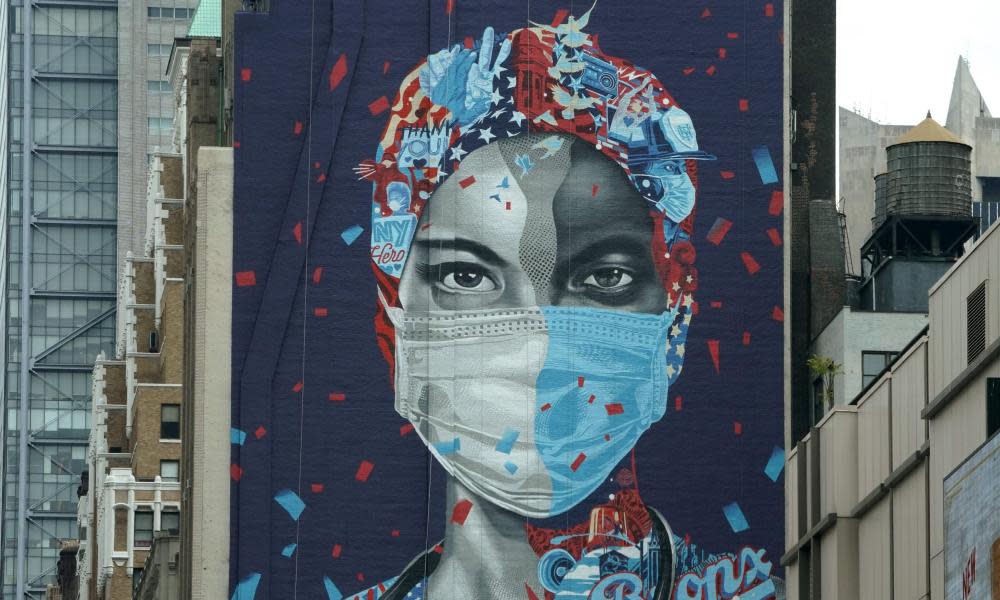'We're on the other side of the mountain': Cuomo hails falling rate of coronavirus infections

As parts of New York prepared to reopen on Friday, the governor said new infections had fallen to the same rate as 19 March, the date he said the state “went into the abyss”.
Related: No quarantine for Mike Pence despite rash of Covid-19 cases in White House
Giving his daily press briefing in Rochester, Andrew Cuomo said: “In many ways, from my point of view, we’re on the other side of the mountain.”
Cuomo shut down the entire state on 22 March, as the New York City area emerged as a global pandemic hotspot. According to researchers at Johns Hopkins University, the state has recorded 335,395 coronavirus cases and 26,641 deaths, about a third of all fatalities in the US.
But Monday also brought news of a potentially dramatic undercount of deaths in New York City. According to an analysis by the federal Centers for Disease Control and Prevention (CDC), between mid-March and early May, about 24,000 more people died in the city than researchers would ordinarily expect, based on the season.
That was about 5,300 more deaths that had been attributed to the coronavirus during that period. At his own press conference on Monday, Mayor Bill de Blasio said that “unless something miraculous happens”, lockdown measures were “going into June”.
The outbreak has been less severe in smaller cities and rural areas and Cuomo said three upstate regions had met all criteria for opening some business activity after 15 May: the Southern Tier, Mohawk Valley and the Finger Lakes.
Other upstate regions could follow soon, Cuomo said, though the reopening regions still needed to work out logistics such as creating regional “control rooms” to monitor the effects of reopening.
Cuomo said the reopening would happen in four phases. The first businesses able to open would include construction, manufacturing and retail with curbside pickup. Additionally, landscaping and gardening businesses and drive-in theaters would be able to open statewide, the governor said, adding that the state was also relaxing restrictions on low-risk outdoor activities such as tennis.
“This is the next big step in this historic journey,” Cuomo said, adding that “all the arrows are pointed in the right directions” and noting that hospitalizations were also in decline.
The state is recording about 488 new infections per day, he said, which is “right about where we started before we went into the heart of this crisis”.
There had been 161 new deaths in New York in the previous 24 hours.
Cuomo said there were now 93 cases of a mysterious illness with symptoms similar to Kawasaki disease that affects children and is believed to be related to Covid-19. At least three deaths believed to be linked to the illness have been reported in New York.
To open, regions of New York must meet a range of criteria.
They include 14-day declines in hospitalizations and hospitalized deaths or falls in new hospitalizations or deaths on average per day, across a three-day period; measures regarding the availability of hospital and intensive care beds in case of a surge in infections; the ability to administer 30 tests per thousand residents a day; and the presence of 30 contact tracers for every 100,000 residents.
Contact tracers will be trained online by the Johns Hopkins Bloomberg School of Public Health, which developed the course with Bloomberg Philanthropies, the charitable foundation of the former New York city mayor Michael Bloomberg.
When someone becomes newly infected with the virus, tracers will be tasked with figuring out everyone who might have had contact with that person, reaching out and advising them how to quarantine themselves until they know for certain they aren’t sick too.
On Twitter, Cuomo wrote: “What New Yorkers have done, nobody could have imagined. The people accomplished a great feat in flattening the curve. We need New Yorkers to show that same resolve and intelligence in this next phase.”
His approach stood in contrast to that of Donald Trump, who said bullishly on Twitter “coronavirus numbers are looking MUCH better, going down almost everywhere”.
According to a New York Times database, new cases are decreasing in just 14 of the 50 states. Among them are densely populated states like New York and Michigan. The list also includes sparsely populated states like Montana and Alaska.
New cases are still rising in nine states, including Arizona, which was pressing ahead with reopening on Monday. In the remaining states, the rate of new cases has remained relatively steady.
Trump criticized Pennsylvania, a battleground state led by a Democratic governor, for not moving faster to reopen its economy. The president also accused Democrats across the US of intentionally slowing the return to normalcy, in order to hurt his chances of re-election.
Related: Covid-19: nursing homes account for 'staggering' share of US deaths, data show
The Associated Press has reported that top White House officials for weeks suppressed guidelines for reopening the economy that were drafted by top disease control experts.
Public health experts at the Centers for Disease Control and Prevention (CDC) reportedly spent weeks preparing guidance for schools, childcare centers, businesses, bars and restaurants. The plan featured a phased reopening and advised “communities as a whole on testing, contact tracing and other fundamental infection control measures”.
Robert Redfield, the CDC director, defended the decision not to release the guidance, saying in a statement he had not formally approved it. The statement contradicts his own internal emails that were leaked to the AP.

